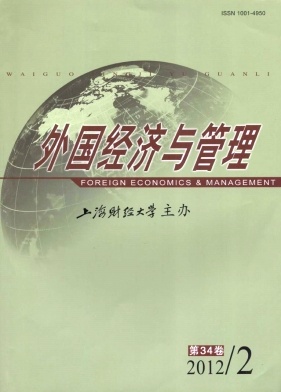跨国公司“结构追随战略”研究脉络梳理与基于知识基础论的框架重构
外国经济与管理 2012 年 第 34 卷第 02 期, 页码:17 - 26
摘要
参考文献
摘要
本文在回顾有关跨国公司组织结构与战略匹配关系的理论研究的基础上,首先对相关理论研究进行了脉络梳理和评析,然后从知识(资源)基础论的视角把不同阶段的组织结构与战略匹配研究成果重新整合成一个包容性更强的跨国公司组织结构与知识获取战略匹配权变研究框架,最后对未来相关研究进行了展望。
[1]Barney J.Firm resources and sustained competitive advantage[J].Journal of Management,1991,17(1):99-120.
[2]Bartlett C and Ghoshal S.Beyond the M-form:Toward a mana-gerial theory of the firm[J].Strategic Management Journal,1993,14(1):23-46.
[3]Chi T,et al.Knowledge-based resources as determinants of MNC structure:Tests of an integrative model[J].Journal of International Management,2004,10(2):219-238.
[4]Devinney T M and Midgley D F.The optimal performance of the global firm:Formalizing and extending the integration-res-ponsiveness framework[J].Organizational Science,2000,11(4):674-695.
[5]Dunning J.Reappraising the eclectic paradigm in an age of alli-ance capitalism[J].Journal of International Business Studies,1995,26(3):461-491.
[6]Durcikova A and Gray P.How knowledge validation processes affect knowledge contribution[J].Journal of Management In-formation Systems,2009,25(4):81-107.
[7]Egelhoff W G.Strategy and structure in multinational corpora-tions:An information-processing approach[J].Administrative Science Quarterly,1982,27(2):435-458.
[8]Frick J,et al.Environmental knowledge and conservation be-havior:Exploring prevalence and structure in a representative sample[J].Personality and Individual Differences,2004,37(8):1597-1613.
[9]Gooderham P N and Ulset S.Beyond the M-form:Towards a critical test of the new form[J].International Economic Busi-ness,2002,9(1):117-138.
[10]Habib M and Victor B.Strategy,structure and performance of US manufacturing and service MNCs:A comparative analy-sis[J].Strategic Management Journal,1991,12(3):589-606.
[11]Hass M R.The double-edged swords of autonomy and exter-nal knowledge:Analyzing team effectiveness in a multinational organization[J].Aademy of Management Journal,2010,53(5):989-1008.
[12]Holm U and Sharma D.Subsidiary marketing knowledge and strategic development of the multinational corporation[J].Journal of International Management,2006,12(1):47-66.
[13]Hout R,et al.How global companies win out[J].Harvard Business Review,1982,60(5):98-108.
[14]Kuivalainen O,et al.Firms’degree of born-globalness,inter-national entrepreneurial orientation and export performance[J].Journal of World Business,2007,42(3):253-267.
[15]Lyles M.The impact of managerial networking intensity and market-based strategies on firm growth during institutional upheaval:A study of small and medium-sized enterprises in a transition economy[J].Journal of International Business Studies,2010,41(2):287-307.
[16]Pitts R and Daniels J.Aftermath of the matrix mania[J].Co-lumbia World Bussiness,1984,19(2):48-54.
[17]Martine X and Solomon R.Tacitness and international ex-pansion:A study of direct investment in knowledge intensive industry[J].Organization Science,2003,14(3):297-311.
[18]Roth K and Morrison A.An empirical analysis of the integra-tion-responsiveness framework in global industries[J].Journal of International Business Studies,1990,21(4):541-564.
[19]Saliola F and Zanfei A.Multinational firms,global value chains and the organization of knowledge transfer[J].Re-search Policy,2009,38(2):369-381.
[20]Spender W.Making knowledge the basis of a dynamic theoryof the firm[J].Strategic Management Journal,1996,17(Wint.S.I.):45-62.
[21]Sumelius J and Sarala R.Knowledge development in MNC subsidiaries:The influence of MNC internal and external knowledge and control mechanisms[J].Economic Journal,2008,50(4):245-258.
[22]Tang F C,et al.Implication of network size and structure on organizations’knowledge transfer[J].Expert Systems with Applications,2008,34(2):1109-1114.
[23]Tang F C,et al.Disseminative capacity,organizational struc-ture and knowledge transfer[J].Expert Systems with Applica-tions,2010,37(2):1586-1593.
[24]Willem A and Buelens M.Knowledge sharing in inter-unit cooperative episodes:The impact of organizational structure dimensions[J].International Journal of Information Manage-ment,2009,29(1):151-160.
[25]Wolf J and Egelhoff W.A reexamination and extension of in-ternational strategy-structure theory[J].Strategic Manage-ment Journal,2002,23(2):181-189.
[26]Zhao J and Zheng A.A multilevel perspective on knowledge transfer:Evidence from the Chinese automotive industry[J].Strategic Management Journal,2009,30(9):959-983.
[2]Bartlett C and Ghoshal S.Beyond the M-form:Toward a mana-gerial theory of the firm[J].Strategic Management Journal,1993,14(1):23-46.
[3]Chi T,et al.Knowledge-based resources as determinants of MNC structure:Tests of an integrative model[J].Journal of International Management,2004,10(2):219-238.
[4]Devinney T M and Midgley D F.The optimal performance of the global firm:Formalizing and extending the integration-res-ponsiveness framework[J].Organizational Science,2000,11(4):674-695.
[5]Dunning J.Reappraising the eclectic paradigm in an age of alli-ance capitalism[J].Journal of International Business Studies,1995,26(3):461-491.
[6]Durcikova A and Gray P.How knowledge validation processes affect knowledge contribution[J].Journal of Management In-formation Systems,2009,25(4):81-107.
[7]Egelhoff W G.Strategy and structure in multinational corpora-tions:An information-processing approach[J].Administrative Science Quarterly,1982,27(2):435-458.
[8]Frick J,et al.Environmental knowledge and conservation be-havior:Exploring prevalence and structure in a representative sample[J].Personality and Individual Differences,2004,37(8):1597-1613.
[9]Gooderham P N and Ulset S.Beyond the M-form:Towards a critical test of the new form[J].International Economic Busi-ness,2002,9(1):117-138.
[10]Habib M and Victor B.Strategy,structure and performance of US manufacturing and service MNCs:A comparative analy-sis[J].Strategic Management Journal,1991,12(3):589-606.
[11]Hass M R.The double-edged swords of autonomy and exter-nal knowledge:Analyzing team effectiveness in a multinational organization[J].Aademy of Management Journal,2010,53(5):989-1008.
[12]Holm U and Sharma D.Subsidiary marketing knowledge and strategic development of the multinational corporation[J].Journal of International Management,2006,12(1):47-66.
[13]Hout R,et al.How global companies win out[J].Harvard Business Review,1982,60(5):98-108.
[14]Kuivalainen O,et al.Firms’degree of born-globalness,inter-national entrepreneurial orientation and export performance[J].Journal of World Business,2007,42(3):253-267.
[15]Lyles M.The impact of managerial networking intensity and market-based strategies on firm growth during institutional upheaval:A study of small and medium-sized enterprises in a transition economy[J].Journal of International Business Studies,2010,41(2):287-307.
[16]Pitts R and Daniels J.Aftermath of the matrix mania[J].Co-lumbia World Bussiness,1984,19(2):48-54.
[17]Martine X and Solomon R.Tacitness and international ex-pansion:A study of direct investment in knowledge intensive industry[J].Organization Science,2003,14(3):297-311.
[18]Roth K and Morrison A.An empirical analysis of the integra-tion-responsiveness framework in global industries[J].Journal of International Business Studies,1990,21(4):541-564.
[19]Saliola F and Zanfei A.Multinational firms,global value chains and the organization of knowledge transfer[J].Re-search Policy,2009,38(2):369-381.
[20]Spender W.Making knowledge the basis of a dynamic theoryof the firm[J].Strategic Management Journal,1996,17(Wint.S.I.):45-62.
[21]Sumelius J and Sarala R.Knowledge development in MNC subsidiaries:The influence of MNC internal and external knowledge and control mechanisms[J].Economic Journal,2008,50(4):245-258.
[22]Tang F C,et al.Implication of network size and structure on organizations’knowledge transfer[J].Expert Systems with Applications,2008,34(2):1109-1114.
[23]Tang F C,et al.Disseminative capacity,organizational struc-ture and knowledge transfer[J].Expert Systems with Applica-tions,2010,37(2):1586-1593.
[24]Willem A and Buelens M.Knowledge sharing in inter-unit cooperative episodes:The impact of organizational structure dimensions[J].International Journal of Information Manage-ment,2009,29(1):151-160.
[25]Wolf J and Egelhoff W.A reexamination and extension of in-ternational strategy-structure theory[J].Strategic Manage-ment Journal,2002,23(2):181-189.
[26]Zhao J and Zheng A.A multilevel perspective on knowledge transfer:Evidence from the Chinese automotive industry[J].Strategic Management Journal,2009,30(9):959-983.
引用本文
关涛, 薛求知. 跨国公司“结构追随战略”研究脉络梳理与基于知识基础论的框架重构[J]. 外国经济与管理, 2012, 34(2): 17–26.
导出参考文献,格式为:
下一篇:外来者劣势研究前沿探析与未来展望





 7633
7633  727
727

